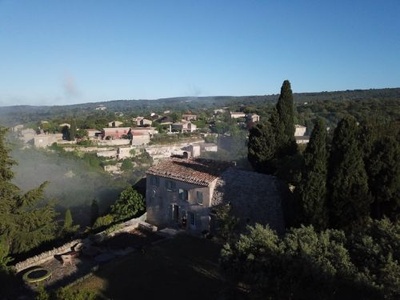Contact us
Provence Luberon
Sotheby's International Realty
Sotheby's International Realty
- Place du Château
- 84220 GORDES, France
- +33 4 90 72 55 00
Provence Luberon
Sotheby's International Realty
Sotheby's International Realty
- 97 place du 8 Mai
- 84380 MAZAN, France
- +33 4 65 09 00 96
Send an email
Tradition: the thirteen desserts of Provençal Christmas
The Christmas meal in Provence ends with the 13 desserts

According to tradition, the Christmas Eve celebrated in Provence ends with thirteen desserts. Set on the third tablecloth, surrounded by three candlesticks and three plates of wheat germ - symbols of the Trinity - each picks up these appetizing assortments. Served on the evening of December 24 after the "Gros Souper", the thirteen desserts bring together the whole family on the return of the midnight mass. Although they vary from one region to another, they usually include dried or begging fruits, nougats from Provence and seasonal fruits.
Among the must-see are:
The oil pump, also known as gibassier or fougasse in Arles and Haute-Provence, this brioche sweetened with olive oil and orange blossom to be broken by hand should not be forgotten.
The four beggars who represent by their colors the clothes of the different Catholic orders having made vows of poverty: walnuts and hazelnuts, symbol of the Augustinians, dried figs for the Franciscans, almonds for the Carmelites and raisins for the Dominicans.
The two nougats: White nougat with hazelnuts, pine nuts and pistachios, sweet and unctuous, it incarnates for some purity and good. While black nougat with melted honey cooked and almonds, hard and brittle embodies the impure and evil.
This classical list is obviously to be completed in order to arrive at thirteen in order to respect the Christian symbolic meaning; the thirteen number referring to Jesus and his twelve apostles. The host chooses them according to their mood and preferences. Here is our small selection:
Seasonal fresh fruits such as apples, pears, grapes or oranges, mandarins, clementines, once considered as signs of wealth.
Dates that represent Christ from the East. They may be stuffed with pink or green almond paste.
Calissons from Aix, "calissoun" in Provençal, are small sweets in the form of shuttle. Specialty of Aix-en-Provence since the 15th century, the calisson is often scented with orange blossom. It is made of preserved melon paste as well as crushed almonds and then covered with royal ice.
Atriums are a variation of flat, crunchy donuts with sugar. This delicacy represents the rich bread to mark the end of Lent.
Quince paste or candied fruit are fruit-based confections. Thanks to the sugar, the fruits will be able to be preserved more easily. Moreover, it is a delight for the gourmands.
Or the Christmas melon, also called Verdau. Recognizable by its green color, the melon is kept in the shelter in the straw. This fruit has a very sweet taste and its flesh is white. It is enjoyed with pleasure and lightness after the Christmas dinner.
Even though the champagne has largely dethroned the cooked wine, the thirteen desserts can also be tasted with ratafia of cherries or cartagena. Once the tasting is finished, all that remains will be to tie the four corners of the third tablecloth to make a bundle and bring the reliefs of the supper to the poor.
Provence Luberon Sotheby's International Realty: Your specialist in luxury real estate in the Luberon and Provence.
Among the must-see are:
The oil pump, also known as gibassier or fougasse in Arles and Haute-Provence, this brioche sweetened with olive oil and orange blossom to be broken by hand should not be forgotten.
The four beggars who represent by their colors the clothes of the different Catholic orders having made vows of poverty: walnuts and hazelnuts, symbol of the Augustinians, dried figs for the Franciscans, almonds for the Carmelites and raisins for the Dominicans.
The two nougats: White nougat with hazelnuts, pine nuts and pistachios, sweet and unctuous, it incarnates for some purity and good. While black nougat with melted honey cooked and almonds, hard and brittle embodies the impure and evil.
This classical list is obviously to be completed in order to arrive at thirteen in order to respect the Christian symbolic meaning; the thirteen number referring to Jesus and his twelve apostles. The host chooses them according to their mood and preferences. Here is our small selection:
Seasonal fresh fruits such as apples, pears, grapes or oranges, mandarins, clementines, once considered as signs of wealth.
Dates that represent Christ from the East. They may be stuffed with pink or green almond paste.
Calissons from Aix, "calissoun" in Provençal, are small sweets in the form of shuttle. Specialty of Aix-en-Provence since the 15th century, the calisson is often scented with orange blossom. It is made of preserved melon paste as well as crushed almonds and then covered with royal ice.
Atriums are a variation of flat, crunchy donuts with sugar. This delicacy represents the rich bread to mark the end of Lent.
Quince paste or candied fruit are fruit-based confections. Thanks to the sugar, the fruits will be able to be preserved more easily. Moreover, it is a delight for the gourmands.
Or the Christmas melon, also called Verdau. Recognizable by its green color, the melon is kept in the shelter in the straw. This fruit has a very sweet taste and its flesh is white. It is enjoyed with pleasure and lightness after the Christmas dinner.
Even though the champagne has largely dethroned the cooked wine, the thirteen desserts can also be tasted with ratafia of cherries or cartagena. Once the tasting is finished, all that remains will be to tie the four corners of the third tablecloth to make a bundle and bring the reliefs of the supper to the poor.
Provence Luberon Sotheby's International Realty: Your specialist in luxury real estate in the Luberon and Provence.





